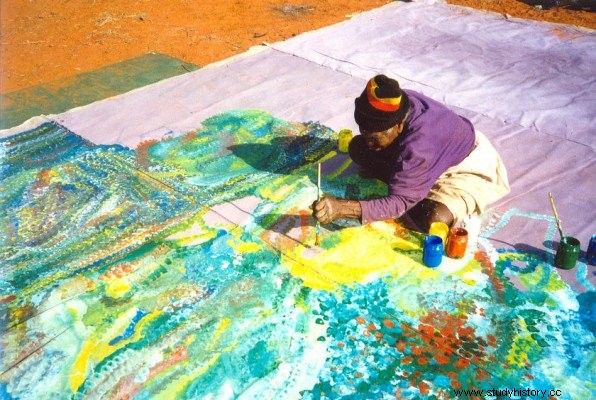Emily Kame Kngwarreye (1910 – 1996) is one of Australia’s most famous and talented Aboriginal artists of contemporary times.

A life in the desert
Emily Kame Kngwarreye was born in 1910 in Australia, among the Anmatyerre people. She grew up in the desert area of Alhalkere, in what would later be Utopia territory, with her brother and sister. At the time, she had few contacts outside of her people. She married twice:first in an arranged marriage, then in a love marriage.
Emily has no children but bonds with her nieces; she raised her sister-in-law's daughter, Barbara Weir, until she was about nine years old. Barbara will be part of the "Stolen Generations", those Australian Aboriginal children forcibly taken from their parents by the Australian government. Supposed dead by her family, the little girl will be raised by foster families and will not be reunited with her mother and aunt until she is in her twenties.
A late artistic career
Emily Kame Kngwarreye's first contacts with the artistic life are through Aboriginal traditions, by the creation and realization of motifs for ceremonies. It was at the age of 70 that, along with the rest of the Aboriginal community of Utopia, she discovered the art of batik, an ancient technique of painting on textiles practiced in West Africa, in the Middle East and Asia.
Tired of the physically demanding batik production technique, Emily then began to paint on canvas.
“I didn’t want to continue with the hard work batik required – boiling the fabric over and over, lighting fires, and using up all the soap powder, over and over. That's why I gave up batik and changed over to canvas – it was easier. My eyesight deteriorated as I got older, (…) it was better for me to just paint. »
(I didn't want to do the hard work that batik entails - boiling fabric over and over, lighting fires, using soap powder over and over again. That's why I gave up batik and switched to canvas. It was easier. My eyesight deteriorated as I got older, (…) it was better for me to paint.)
My dreams
In the years 1988/1989, members of the Central Australian Aboriginal Media Association (CAAMA), visiting to disseminate Aboriginal culture, introduce acrylic painting to the community of Utopia. They organize an exhibition of the paintings, and Emily's works immediately meet with great success.
Guided at first by her art teacher Geoffrey Bardon [English], Emily Kame Kngwarreye quickly explored her own style, with paintings initially composed of dots of paint of different sizes and colors. She draws her inspiration from her region of origin, from her experience as an aboriginal woman from Alhalkere. When asked to explain her paintings, she replies:
“Whole lot, that's whole lot, Awelye (my Dreaming), Arlatyeye (pencil yam), Arkerrthe (mountain devil lizard), Ntange (grass seed), Tingu (Dreamtime pup), Ankerre (emu), Intekwe (favourite food of emus, a small plant), Atnwerle (green bean), and Kame (yam seed). That's what I paint, whole lot. »
(Everything, I paint everything, Awelye (my dreams), Arlatyeye (yam), Arkerrthe (lizard), Ntange (grass seed), Tingu (dream puppy), Ankerre (emu), Intekwe (a plant, food favorite of emus), Atnwerle (green bean), and Kame (yam seed). That's what I paint, everything.)
Style and inspiration
Emily Kame Kngwarreye painted first for CAAMA and then for an Aboriginal art gallery in Melbourne. Quickly, his paintings attract attention and demand increases. Despite her advanced age, she painted for years on average one painting per day; his works fetched high prices at auction, bringing over a million dollars to the Utopia community between 1989 and 1990.
His style evolves, moving from colored dots to colored parallel lines representing rivers and land. His line thickens, his points widen. She adds rings of color and lines that criss-cross the canvas, alluding to building blocks of life in the Alhalkere desert:essential to survival, the yam in particular features heavily in her work.
Emily's success
The success that Emily Kame Kngwarreye meets, with the increase in demand, ends up causing her problems. In particular, she was under pressure from the white community, which commissioned paintings from her, asking her to adapt her technique to one style rather than another. She also receives unsolicited attentions, and will tell a friend that she once escaped "five or six wagons of seedy art dealers" in Utopia. Until the end of her career, she will be pursued by sellers wanting to acquire her art.
Emily Kame Kngwarreye died in September 1996 in Alice Springs. The first solo exhibition of his works will take place in Amsterdam in 1999. In 2013, the Emily Museum opens in Cheltenham, Australia; it is the first museum dedicated to a single Aboriginal artist.
